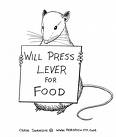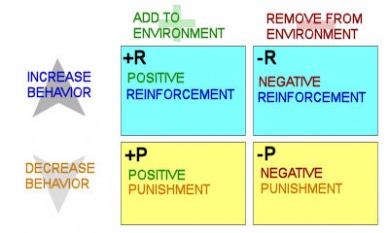What is Operant Conditioning?

Operant conditioning says, "When a reinforcer follows a response - regardless of the conditions that might have led to its emission - the result will be an increase in the probability that this response will occur again under similar circumstances" (Lefrancois, 2006). It is the process of changing behavior by manipulating its consequences. Most of Skinner's work investigates the principles of operant conditioning. Skinner based his idea on the belief that the consequences of behavior determine the probability that the behavior will occur again (Lefrancois).
Check out this video in which B.F. Skinner explains operant conditioning!
Technical Terms in Operant Conditioning
The technical term for something that's added to an environment is positive.
The technical term for something that's subtracted from an environment is negative.
Anything that increases a behavior is a reinforcer. If an object is perceived as worth pursuing, then commonly the individual will repeat the behaviors that seem to cause these consequences. These consequences will increase the behaviors that lead to them, so they are reinforcers. They strengthen the behavior.
Anything that decreases a behavior is termed a punisher. If an object is perceived as worth avoiding, then commonly the individual will not repeat the behaviors that seem to cause these consequences. These consequences will decrease the behaviors that lead to them, so they are punishers.
Something Good can start or be presented, so behavior increases = Positive Reinforcement (R+)
Something Good can end or be taken away, so behavior decreases = Negative Punishment (P-)
Something Bad can start or be presented, so behavior decreases = Positive Punishment (P+)
Something Bad can end or be taken away, so behavior increases = Negative Reinforcement (R-)
(Braslau-Schneck, 1998)
Here is a chart that better explains what Positive/Negative Reinforcement and Punishment look like:
Examples of Operant Conditioning
Some examples of operant conditioning include:
* Children completing homework to earn a reward from a parent or teacher
* Employees finishing projects to receive praise or promotions
In these examples, an increase in behavior occurs because there is the promise or possibility of rewards.
However, operant conditioning can also be used to decrease a behavior. The removal of an undesirable outcome or the use of punishment can be used to decrease or prevent undesirable behaviors. For example:
* A child may be told he or she will lose recess privileges if they talk out of turn in class.
This potential for punishment may lead to a decrease in disruptive behaviors.
(Braslau-Schneck, 1998)
For more information on operant conditioning, check out these links!
Operant Conditioning http://www.scholarpedia.org/article/Operant_conditioning
Provides the definitions of operant conditioning, traces its history, and describes the theories associated with it!
Home Skinner Reinforcement and Punishment Positive Behavior Support References

